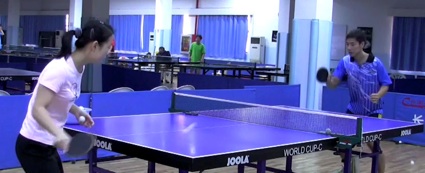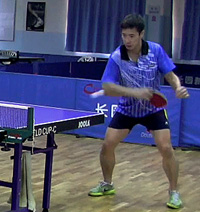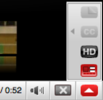
| In the Shenzhen training sessions, after 8-10 minutes of forehand forehand warm-up, I always segue into the backhand backhand drill. However, instead of the classic penhold backhand using the same side of the paddle as on the forehand, in Shenzhen I learned to make exclusive use of the reverse side of the paddle for backhand shots. |

|
Let's call this the modern penhold backhand. The modern style has significant advantages over the classic penhold backhand: principally, with respect to the the (topspin) loop attack, but also with respect to flicking the short ball. In later entries, I will attempt to illustrate the multiple advantages of the new style, for now I will simply discuss the continuation of the warm-up using the reverse backhand.

I'd like to emphasize that this is a new stroke that I picked up during my stay in Shenzhen. Here, the topic is the backhand backhand drill where I'm simply hitting the ball. Again, it's used mostly as a warm-up device. (The backhand loop against non-underspin and underspin will be covered in later entries.) In the following one minute clip (taken from a 10 minute session), you can also see the coach reminding me about the importance of a proper followthrough. As anyone who has needed to retrain muscle memory knows, it can be difficult to make adjustments while attempting to time the ball correctly and still manage to place the return on the table. Patience and continual reinforcement is a necessary component of the re-wiring process. Direct link to the Youtube clip:
[
| Clip was uploaded in 1280 x 720 HD format. You may be able to select HD instead of SD sometimes... Aha, I finally figured it out! I seem to have to play it once in SD in full screen mode. Then on replay, the HD symbol becomes visible/selectable on the tab: |  |
- Start stroke from the stomach on out.
The stroke is initiated from the body shift. Bring stomach back/in before initiating the stroke. - Try to think point of contact to be in front of the body.
Not to the side. Quick recovery for the next ball is next to impossible otherwise. - Always lean forwards.
Sometimes when the ball is unexpectedly deep, I tend to straighten the upper body and even lean backwards. - Be aware of the options to angle the paddle using the wrist.
You can adjust the direction to return the ball to the same spot, for example, during a drill.

Great reverse penhold backhand you've got there. Do you curl your fingers on backhand side or keep them straight?Also what equipment do you use?
ReplyDeleteFinger are left natural, not overly straight or curved.
ReplyDeleteEquipment is simple.
Sword RG-SER90 blade (China)
Donic Coppa JO Platin/Silver rubber.
i just started to use it but i dont know that whether is it hit the side or middle of the ball
ReplyDeleteI really want to learn RPB, but mostly I mess up, since I do not the proper way. I'm a pendhold user, never shakehand since it's kind of the korean way, but what can I do to make it consistent?
ReplyDeleteWhat does“never shakehand since it's kind of the korean way”mean? You use one side to attack on backhand like Korean player Kim Taek Soo? That's awesome! not many people can do that in the world.
ReplyDeleteThe blogger has a good reverse backhand, you can imitate his stroke, but initially you can hit the ball lightly and keep your paddle steady, slow down the tempo, don't use too much wrist,use more forearm. Hit the ball at the top point, don't hit too hard, try to get a feeling for the ball, when you feel you can control the ball then you can make it consistent.
Hope it can help you.